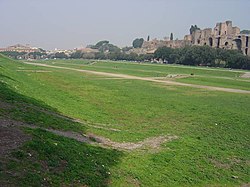马克西穆斯竞技场
马克西穆斯竞技场(意大利语:Circo Massimo,拉丁语:Circus Maximus,意为“大竞技场”)是一个古罗马竞技场,位于意大利罗马市,坐落于阿文提诺山与帕拉蒂尼山之间。马克西穆斯竞技场是古罗马时代第一个竞技场,也是最大的一座。马克西穆斯竞技场长621米(2,037英尺),宽118米(387英尺),可以容纳150,000人[1]。马克西穆斯竞技场也是古罗马时代建造竞技场的典范。
| 马克西穆斯竞技场 Circus Massimus | |
|---|---|
 | |
| 基本信息 | |
| 位置 | 意大利罗马市 |
| 坐标 | 41°53′09″N 12°29′09″E / 41.8859°N 12.4857°E |
| 详细规格 | |
| 长度 | 621米(2,037英尺) |
| 宽度 | 118米(387英尺) |
| 地图 | |
 | |

历史
编辑古罗马时代
编辑在古罗马著名的历史学家蒂托·李维巨作《罗马史》中,描述伊特拉斯坎文明的罗马国王曾经计划在竞技场高处建造王座,以供罗马骑士阶级与贵族来使用。罗马王政时代第七任君主卢修斯·塔克文·苏佩布则在低处为平民设置座位。除此之外,直到罗马王国晚期,马克西穆斯竞技场很可能仍然小于附近农田的道路,虽然这些道路目前已经消失不见,但是竞技场内的木制座位因为容易毁坏,所以经常整修或重建。这些木制座位后来在罗马王政时代被石制座位所取代。
共和国时代
编辑在公元前494年,独裁官马克西穆斯与其后裔获得权力在东南端设置高官座(curule sea),这里拥有观赏竞赛的绝佳视野[2]。公元前190年,在监察官的命令之下,跑道两旁开始设置石制座位,以供元老院成员就坐[3]。
公元前329年开始建造永久性的木造隔间,表面经过粉刷显得相当明亮[4],前面则有一个匝口,每一个匝口与中央竞技场的距离相当。理论上,竞技场可以容纳25组四马双轮战车并排使用。到了共和国时代晚期至帝国时代早期,马克西穆斯竞技场拥有12个隔间,而12组四马双轮战车可以同时在场上奔驰。人们可以对每个隔间进行投注,而不同的组别也用颜色区别出来[5]。至少从公元前174年开始,人们使用卡斯特与巴勒克斯(Castor and Pollux)蛋雕像来预测马匹的骑士。公元前33年,巨大的铜制海豚形计数器被设置在竞技场中[6]。
凯萨在公元前50年继续扩张马克西穆斯竞技场,将座位延伸至跑道范围内。当时马克西穆斯竞技场长621米(2,037英尺),宽118米(387英尺)。而跑道周围的水道遭到截断。历史学家并不知道马克西穆斯竞技场当时拥有多少座位,古罗马作家老普林尼认为有250,000个座位[7],但是这个数字不太可信,比较可能是150,000个座位。木制的露天看台于公元前31年被火焚毁[8] 。
帝国时代
编辑屋大维后来将公元前31年遭火焚毁的部分修复完成,部分材料取自屋大维耗费巨资从埃及赫里奥波里斯带回来的方尖碑,这些方尖碑是埃及人献给埃及太阳神的象征[9]。形容马克西穆斯竞技场是罗马最美丽、最令人称羡的建筑。
可能是因为马克西穆斯竞技场拥有匝口的缘故,所以竞技场原本容易遭到水灾侵袭[10],直到克劳狄一世在竞技场设置防灾设施后才得以改善。因为竞技场的露天看台与工作房是木造建筑,所以容易遭受火灾侵袭。公元64年,马克西穆斯竞技场在尼禄统治时期遭遇到罗马大火,并造成严重的伤害。后来马克西穆斯竞技场重新修复完成后,仍然举行许多竞赛与庆典。
公元81年,元老院为了纪念提图斯,在马克西穆斯竞技场建造一座凯旋门,取代原本的凯旋门。图密善后来建造一座复合宫殿与马克西穆斯竞技场相连结。因为图密善喜欢观赏竞赛,所以他在遇刺之前,已经决定修缮马克西穆斯竞技场。在图拉真时代后,马克西穆斯竞技场并未有重大改变。一些皇帝于竞技场中设置一些纪念物,而卡拉卡拉则新建隔间的匝口[11]。
罗马帝国之后
编辑随着基督教成为罗马帝国的官方宗教,罗马人的传统竞技逐渐式微,马克西穆斯竞技场使用的机会也越来越少。最后一次于马克西穆斯竞技场举行斗兽活动是在523年,而东哥德国王巴杜伊拉(Baduila)于549年最后一次于马克西穆斯竞技场举办田径比赛[12]。
12世纪时,一条水道建设完成,用来灌溉农田。到了1500年时,这个地区成为市集广场[13]。
现状
编辑马克西穆斯竞技场只有一小部分保存至今,包括跑道与中央栅栏的外围。一些匝口仍然存在,但是大部分的座位都已经消失了。教宗思道五世于1587年将方尖碑移到其他地方,其中一根目前位于人民广场。
延伸阅读
编辑- Filippo Coarelli, Guide archéologique de Rome, 1991, p. 225-228 (ISBN 2-01-235428-9)
- Jean-Paul Thuillier, Le Sport dans la Rome Antique, Paris, Errance, 1997
- Humphrey, John, Roman circuses: arenas for chariot racing, University of California Press, 1986.[14]
参考资料
编辑- ^ This is a modern recalculation of the seating capacity at the Circus, a substantial downward revision of Pliny the Elder's estimate of 250,000. For discussion see Humphrey, p. 216.
- ^ In the earliest exercise of the right, a curule chair would have been brought to the spot; its permanent positioning there is unlikely. See Humphrey, p. 61.
- ^ Livy has the plebs seated "promiscuously" (antea in promiscuo spectabant) up to then: see Humphrey, 70.
- ^ Livy, Ab Urbe Condita, 8.20.1
- ^ Humphrey, p. 171; the gates probably used the same animal-sinew torsion springing as the Roman ballista; Ibid, pp. 137 - 138: opposing teams of Reds and Whites are prominent in late Republican literature, and Greens and Blues in the Imperial era. Some Roman authors held that team-racing in multiple colours dated back to the regal era. Ibid, p. 175 for allocation of stalls by lottery.
- ^ Humphrey, pp. 261 - 5.
- ^ Filippo Coarelli, Guide archéologique de Rome, p. 224
- ^ Pliny the Elder's figure of 250,000 circus seats is unreliable; it ignores the necessary interruptions of seating rows by many access stairways and corridors. It might represent a per foot run seating estimate, or include those watching from the nearby heights, outside the building proper. In late Imperial regionary catalogues, seating estimates for the Circus become even wilder; one gives an impossible 450,000 seats. Discussion is in Humphrey, p. 126.
- ^ It was quarried and first dedicated in the reign of Seti I
- ^ The Ludi Martiales of AD 12 were temporarily transferred from the Circus, after a flood.
- ^ Humphrey, pp. 80, 102, 126 - 9. Some repairs were unforeseen and extensive, such as those carried out in Diocletian's reign, after the collapse of a substantial section of seating, which killed some 13,000 people.
- ^ Bowersock, G., Green, P., Grabar, O., Late Antiquity: A Guide to the Postclassical World, Harvard University Press, 1999, p. 674; citing Procopius, The Gothic Wars, 3. 37. 4.[1] (页面存档备份,存于互联网档案馆) For the last known beast-hunt at the Circus, see Humphrey, p. 131. Humphrey describes the last known Circus event (549) as "games".
- ^ Partner, Peter, Renaissance Rome, 1500-1559: a portrait of a society, University of Claifornia Press, 1976, pp.4, 166.googlebooks preview (页面存档备份,存于互联网档案馆)
- ^ 存档副本. [2012-03-23]. (原始内容存档于2012-11-14).
外部链接
编辑- 三维重建马克西穆斯的竞技场 (页面存档备份,存于互联网档案馆) - www.italyrome.info (页面存档备份,存于互联网档案馆)
- Circus Maximus Ipix 360° panorama
- Circus Maximus (页面存档备份,存于互联网档案馆) Art & History